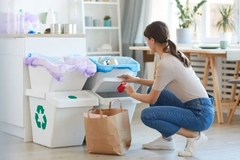Sulapac designs biodegradable thin-walled cosmetic jars for water-based emulsions
20 May 2021 --- Sulapac has produced a new flexible material designed for thin-walled cosmetics jars with “excellent impact strength.”
The brown, natural appearance and haptic feel make it stand out on retailer shelves. Furthermore, the drop-in solution material can be mass-produced with existing plastic machinery.
“Biodegradability and stability with water are contradictory, and therefore, solutions for water-based cosmetic packaging have been lacking,” Dr. Suvi Haimi, CEO and co-founder of Sulapac tells PackagingInsights.
“While around 90 percent of the cosmetics market consists of water-based emulsions, there has not been an alternative for water-based products that biodegrades without leaving permanent microplastics behind,” states the company. “Now, Sulapac has invented a patent-pending material for them.”
Barriers exceeding market demands
Sulapac has also recently launched jars for water-based cosmetics that biodegrade without leaving permanent microplastics. The Sulapac barrier particles biodegrades to 91 percent in 56 days in a marine environment (ASTM D6691).
“We only use raw materials which are not considered harmful to aquatic organisms and do not cause long-term adverse effects in the environment. No release of harmful chemicals or permanent microplastics takes place during the use and end of life,” says Haimi.
Combining the new material with the Sulapac barrier, customers can “provide a compelling portfolio” of different sized jars for both oil and water-based cosmetics.
The Sulapac materials aim to “mimic the beauty, usability and circularity of nature.”“The new Sulapac barrier allows us to continue to offer sustainable innovations that meet and exceed market demands,” says Pierre-Antoine Henry, head of categories at Quadpack, a Sulapac customer commissioning the new material.
“From new capacities to cutting-edge technical solutions, Quadpack is happy to provide an ever-growing product range in Sulapac material to all beauty brands.”
Growing the green footprint
Besides luxury cosmetics, the material and barrier solutions are suitable for food-contact products. They are not considered harmful to aquatic organisms nor cause long-term adverse impacts on the environment.
The jars are made from responsibly sourced raw materials, using feedstock from industrial and agricultural side streams as much as possible.
In a bid to lower carbon emissions, the materials have a lower CO2 footprint than standard polypropylene (PP) jars.
A cradle-to-gate Life Cycle Assessment screening performed by an independent third-party consultancy ranked the Sulapac material’s CO2 emission per kg at 0,7 compared to 1,7 for PP.
Currently, the ideal way to recycle a product made of Sulapac material is via industrial composting.
Mechanical and chemical recycling are also viable options, as Sulapac is developing a closed-loop system. The company is also currently on the lookout to partner with “forerunner cosmetic brands.”
A changing market
Sulapac highlights the beauty and personal care industry is worth over US$500 billion annually and expected to grow annually by 4.75 percent.
On Earth Day this year, PackagingInsights looked at the personal care sector’s efforts to reduce plastic from single-use cosmetics applications.
Innova Market Insights highlights innovation in personal care packaging is largely focused around incorporating recycled materials. However, some brands are also exploring biodegradable packaging, and plastic-reduced or plastic-free alternatives.
Edited by Anni Schleicher












